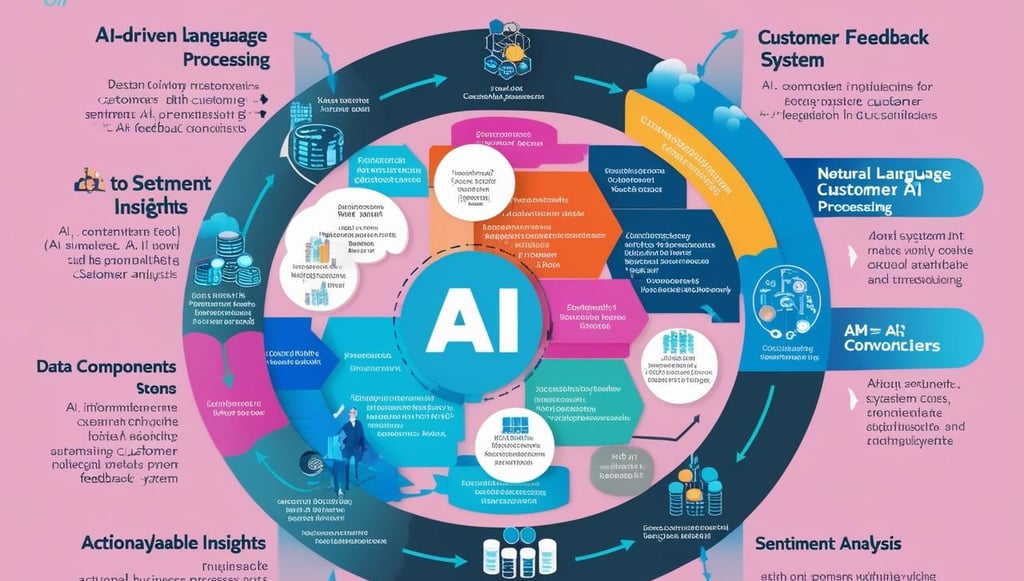Building AI-Driven Customer Feedback Systems
"Learn how to build AI-driven customer feedback systems to enhance insights and improve customer experiences. This guide covers the tools, techniques, and strategies to automate feedback collection and analysis for actionable business decisions."
TUTORIAL AND GUIDE


In today’s competitive marketplace, understanding customer feedback is critical for business success. Traditional feedback systems, often based on surveys and manual reviews, can be time-consuming and limited in scope. Enter AI-driven customer feedback systems: innovative solutions that enable businesses to collect, analyze, and act on customer feedback more effectively than ever before. In this guide, we will explore how to build an AI-driven customer feedback system from scratch and optimize it for your business needs.
Why AI-Driven Feedback Systems Are Essential
1. Scalability: Traditional systems struggle to manage feedback from thousands or millions of customers. AI systems process massive datasets quickly and efficiently.
2. Real-time Insights: AI provides real-time analysis, allowing businesses to address issues as they arise.
3. Actionable Data: AI tools categorize and prioritize feedback, enabling focused action on critical customer concerns.
4. Cost Efficiency: Automating feedback analysis reduces manual labor costs while improving accuracy.
Step 1: Define Objectives for Your Feedback System
Before implementing an AI-driven system, clarify your goals:
- Understand customer pain points: Identify what customers love or dislike about your products/services.
- Improve products/services: Use insights to guide product development and service improvements.
- Boost customer satisfaction: Ensure customer concerns are addressed promptly.
- Measure success: Establish key performance indicators (KPIs) such as Net Promoter Score (NPS) or Customer Satisfaction Score (CSAT).
Step 2: Collect Customer Feedback Data
To train and run an AI system effectively, you need a robust dataset. Sources of customer feedback include:
1. Surveys: Collect structured feedback through forms and questionnaires.
2. Social Media: Monitor comments, mentions, and reviews.
3. Email Correspondence: Extract insights from customer support emails.
4. Review Platforms: Analyze feedback from sites like Yelp, Trustpilot, or Google Reviews.
5. Chat Logs: Use data from customer support chats or chatbots.
Ensure data collection complies with privacy regulations like GDPR or CCPA.
Step 3: Choose the Right AI Tools and Technologies
AI-driven feedback systems rely on multiple technologies. Key tools include:
1. Natural Language Processing (NLP)
NLP enables machines to understand and interpret human language. Use NLP to:
- Perform sentiment analysis.
- Extract keywords and topics.
- Detect recurring themes in feedback.
Popular NLP tools include:
- Google Cloud Natural Language API
- OpenAI’s GPT models
- SpaCy
- NLTK (Natural Language Toolkit)
2. Machine Learning Algorithms
Machine learning (ML) powers predictive analytics and trend identification. Common ML frameworks are:
- TensorFlow
- PyTorch
- Scikit-learn
3. Data Visualization Tools
Visualizing data helps stakeholders grasp insights quickly. Consider:
- Tableau
- Power BI
- Google Data Studio
Step 4: Build and Train Your Feedback System
1. Data Preprocessing
- Clean the data: Remove duplicates, errors, or irrelevant entries.
- Label datasets: Categorize feedback by sentiment (positive, neutral, negative) or topics.
- Tokenize text: Break text into smaller parts for analysis (words, phrases).
2. Train AI Models
- Use labeled data to train supervised learning models.
- Experiment with unsupervised learning for topic modeling.
- Test multiple algorithms to determine the best fit for your data.
3. Evaluate Model Performance
- Use metrics like accuracy, precision, recall, and F1-score.
- Refine models based on feedback and performance results.
Step 5: Integrate the System Into Your Workflow
Once trained, integrate the feedback system into your existing processes. Steps include:
1. Automation: Connect the AI system to your CRM, email platforms, or customer support tools.
2. Dashboard Setup: Create a user-friendly interface for team members to view insights.
3. Feedback Loops: Use the insights to guide customer service and product improvements.
Step 6: Monitor and Optimize the System
Continuous monitoring ensures your system remains effective. Tips include:
1. Regular Updates: Retrain models with new data.
2. Performance Reviews: Monitor KPIs and adjust as needed.
3. Feedback from Teams: Gather input from employees using the system to refine functionality.
Real-World Examples of AI-Driven Feedback Systems
1. Amazon
Amazon uses AI to analyze product reviews and customer queries, ensuring a high level of customer satisfaction.
2. Zappos
Zappos employs sentiment analysis tools to improve customer service experiences.
3. Spotify
Spotify leverages feedback systems to enhance its recommendation algorithms, keeping users engaged.
Benefits and Challenges of AI-Driven Feedback Systems
Benefits
- Improved customer satisfaction.
- Faster resolution of customer issues.
- Enhanced decision-making through actionable insights.
Challenges
- Data Privacy: Ensuring compliance with laws and ethical standards.
- Bias in AI: Addressing any biases in training data.
- Implementation Costs: Initial setup can be resource-intensive.
Future Trends in AI-Driven Feedback Systems
1. Voice Feedback Analysis
AI systems will increasingly analyze voice-based feedback from calls and voice assistants.
2. Multilingual Support
Improved NLP models will allow for seamless analysis of feedback in multiple languages.
3. Hyper-Personalization
AI will enable feedback systems to provide individual-level insights, helping businesses deliver tailored experiences.
Conclusion
Building an AI-driven customer feedback system can transform how businesses understand and serve their customers. By leveraging the latest AI technologies, organizations can gain deeper insights, respond faster, and foster stronger customer relationships. Whether you’re a small startup or a global enterprise, investing in an AI-driven system is a strategic move to stay competitive in the digital age.
Ready to start building your AI-driven customer feedback system? Leverage tools, technologies, and strategies outlined in this guide to revolutionize your customer experience.
Read a more concerned article: "Step-by-Step Guide to Building a Chatbot from Scratch: A Comprehensive Tutorial".

